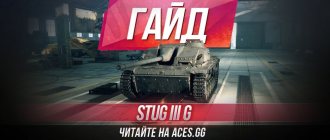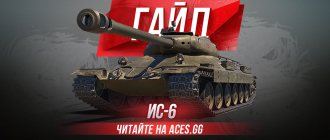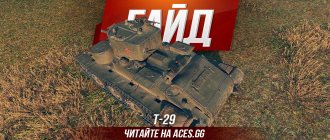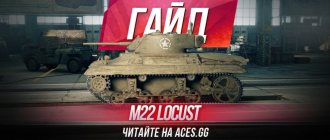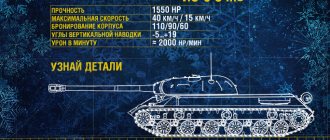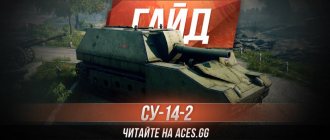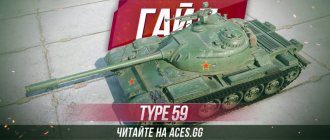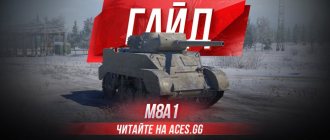Hello to all fans of the stealth style of play, aces.gg is here! The focus of our attention today is another interesting, but far from the most powerful vehicle, the German promotional tank destroyer of the fifth level - this is the StuG IV guide
.
Surely many of you know that this device is issued for the successful completion of the first stage of personal combat missions. That is, it is necessary to perform the StuG IV LBZ
to get this self-propelled gun, as well as to proceed to three more stages and compete for the T28 Concept, T 55A and Object 260.
Before we move on to studying the parameters of this machine, you should also know that the StuG IV WoT
has not a premium status, but a promotional one, that is, the car does not bring more silver from battle, but it can be used to upgrade the crew.
Performance characteristics of StuG IV
First of all, every owner of this unit should know that he has at his disposal a small, but still standard safety margin for the PT-5, and in addition, the StuG IV has a review
very small, this figure is only 310 meters. At the same time, our German has a preferential level of combat and you will not have to fight with equipment higher than level 6, which is good news.
As for the survivability ability, it is low for us, since the StuG IV has characteristics
the reservations are frankly weak. Even in the frontal projection you will not find thicknesses exceeding 109 millimeters, and most areas can boast only 80-88 millimeters thick. Of course, even our classmates can easily penetrate us, and only some vehicles of a level lower than the StuG IV tank can sometimes tank.
Of course, one cannot help but pay attention to the huge anti-cumulative screens covering the entire side. True, you shouldn’t rely on them, their thickness is only 5 millimeters, so from the side projection of the StuG IV World of Tanks tank destroyer
It’s also extremely vulnerable and I don’t recommend turning sideways towards the enemy at all.
However, survivability is affected not only by armor, but also by stealth, which, thanks to the very low silhouette in the case of the StuG IV WoT
worthy of respect. The self-propelled gun actually has a high camouflage coefficient, so detecting it in the bushes is by no means easy.
As for driving performance, in our case this issue is quite controversial and controversial. We can say with confidence that the maneuverability at our disposal is good and the maximum speed is the German tank StuG IV
I got a passable one, but its dynamics are so low that you can only accelerate as much as possible when going down a hill, and this brings a lot of inconvenience.
gun
Looking ahead, I will say that when considering the armament of this self-propelled anti-tank gun, you begin to involuntarily rejoice at the preferential level of combat, because the gun is really not the best.
Let's start with the fact that the StuG IV has a gun
has low one-time damage, but quite a decent rate of fire, so the DPM is approximately 1780 units. This is a good result, but it can’t be called very good either.
The situation with penetration by the standards of tank destroyers is also far from perfect; penetration of strong equipment of the sixth level StuG IV World of Tanks
maybe with great difficulty, targeting vulnerable points, or charging golda. Otherwise, especially being at the top of the list, there shouldn't be any problems, but you still need to shoot wisely.
The accuracy in our case is good, StuG IV tank
boasts a small spread of 100 meters, very fast aiming, but poor stabilization, which is typical for our class of equipment.
Regarding the vertical and horizontal aiming angles, unfortunately, nothing good can be expected. Tank destroyer StuG IV WoT
is capable of lowering the gun only 6 degrees down, and the total UGN is 20 degrees, both results leave much to be desired.
Construction[edit]
The hull of the PzKpfw IV Ausf tank was used as the chassis for the StuG IV assault gun. H (later PzKpfw IV Ausf. J) welded from heterogeneous armor plates. Instead of a tank turret, the Sturmgeschuetz IV was equipped with a wheelhouse welded from armor plates 11–80 mm thick. The roof of the cabin was secured with bolts and was removable, which made it easier to overhaul or replace the gun. The cabin was connected to the hull using bolts and angles. There was a commander's turret in the roof of the cabin. The thickness of the turret armor is 30–50 mm. Next to the loader's hatch on the roof there was an MG 42 machine gun of 7.92 mm caliber. The StuG IV's chassis consisted of eight small-diameter rubber-coated road wheels measuring 470x75x660, assembled into four bogies. The upper section of the track was supported by four (Ausf. H and early Ausf. J) or three (Ausf. J) support rollers. The support rollers were usually all-metal; only a few early machines had rubber tires. Each support roller was suspended on a bearing from an axle, which, in turn, was attached to the side using four M20 bolts. At the end of the war, all-metal road wheels appeared. The guide wheel with a tension mechanism was located at the stern, and the drive wheel with 20 teeth was located at the front. Single-pin, single-ridge tracks Kgs 61/400/120. Track support length 3,720 mm. Manganese steel tracks. In winter conditions, anti-slip teeth and special linings could be put on the tracks, increasing the width of the track. Each caterpillar consisted of 99 tracks. Engine Maybach HL 120 TRN, carburetor, four-stroke, 12-cylinder, in-line, V-shaped (camera block 60°), overhead valve, liquid cooling. Radiators were located to the left and right of the engine. There was a valve system that allowed the engine to be filled with warm or hot water. Air circulation in the engine compartment was provided by two fans located on the right side of the housing. There were two rectangular holes on the engine plate. Air intakes were also located on the sides. Fuel - leaded gasoline OZ 74. Gasoline was poured into three tanks with a total capacity of 430 liters. The first tank held 140 liters, the second 120, and the third 170. Typically, 413 liters of fuel were poured into the tanks. To fill the fuel, two holes located in the area of the support roller were used. Fuel consumption is 195 liters per 100 km, range on the highway is 210 km, 130 km over rough terrain. Two Solex carburetors. Gears were switched using a lever located to the right of the driver's seat. Control was carried out using a steering system, which consisted of planetary turning mechanisms, final drives and drive wheels. Mechanical brakes, Krupp type. The main armament of the vehicle was a 75 mm 7.5 cm StuK 40 L/48 cannon. The gun could fire armor-piercing PzGr 39 shells weighing 6.8 kg and an initial speed of 740-790 m/s, PzGr 40 sub-caliber shells weighing 4.1 kg and an initial speed of 920–1060 m/s, cumulative Gr 38HL/B weighing 4, 4 kg and an initial speed of 870 m/s, high-explosive SpGr 34 weighing 5.72 kg and an initial speed of 590 m/s, as well as smoke NbGr weighing 6.21 kg and an initial speed of 580 m/s. Ammunition 63 rounds. The barrel is rifled with 32 grooves, 7.8 mm deep. Electric descent. Additional armament consisted of a MG 34 (MG 42) machine gun of 7.92 mm caliber (500 rounds), mounted on the roof of the cabin on the so-called Rundumfeuer MG carriage, allowing fire from the fighting compartment. The radio equipment consisted of a FuG 15 and FuG 16 radio station. The FuG 15 type “h” VHF receiver operated in the range 23000–24950 kHz. Operating range 4 km key, 2 km telephone. The FuG 16 transceiver consisted of a 10-watt type “h” transmitter and a type “h” receiver and operated in the range 23000–24950 kHz. Both radio stations had whip antennas 2 meters long. The antennas were attached to the rear wall of the cabin. The car was also equipped with an intercom system. The vehicle commander had an SF 14z (Schrenfernrohr 14z) artillery stereo tube. Seven periscopes were installed in the turret. The driver's mechanic position was equipped with two periscopes. Additional equipment consisted of sapper tools (axe, hammer, crowbar, shovel and scissors for cutting barbed wire). They were transported on the wings of the car. The right wing also had a starter handle, and the left wing had a gun canopy. Two spare road wheels were stored on the left side of the wheelhouse.
Advantages and disadvantages
You all understand perfectly well that in order to play effectively on any machine in our game, you need to clearly understand its strengths and weaknesses. Now we will summarize all of the above and highlight the most important advantages and disadvantages of StuG IV World of Tanks
. Pros: • Low silhouette and excellent camouflage; • Good maneuverability and maximum speed; • Decent accuracy, especially convergence speed; • Good rate of fire and damage per minute; • Preferential level of battles. Cons: • Small visibility and safety margin; • Weak armor in the forehead and sides; • Frankly bad dynamics; • Low one-time damage; • Poor penetration indicators; • Uncomfortable vertical and horizontal aiming angles.
Equipment for StuG IV
To increase your effectiveness in battle, it is important to correctly select and then install additional modules. Frankly speaking, we don’t have many really worthwhile variations in this regard, so the equipment for the StuG IV tank
you should put this: 1. – undoubtedly, the most useful and necessary option, because thanks to it you can deal more damage. 2. is another very good and useful module, because it comprehensively improves several important parameters of the machine. 3. – given our serious problems with the review, this is the only way to achieve acceptable results.
The only possible alternative to the above kit would be to replace the second item with . In this case, we become even more invisible, and accordingly, we increase our survivability, and this replacement goes well with the third point.
History[edit]
It was serially produced from December 1943 to March 1945, with a total of 1,170 vehicles produced. According to the departmental rubricator of the Ministry of Armaments of Nazi Germany, the self-propelled gun was designated as Sd.Kfz.163. The incentive to create such a combat vehicle was the insufficient number of StuG III assault guns. Since the deployment of StuG III production at the existing production facilities (manufacturer of the PzKpfw IV medium tank) was pointless from an economic point of view, a project was developed to install the StuG III wheelhouse on the PzKpfw IV chassis. This project became the starting point for the production of the StuG IV. Since January 1944, it stopped producing the base tank and completely switched to production of the StuG IV. These self-propelled guns were actively used on all fronts of World War II. To date, three copies of the StuG IV have survived (two in Poland and one in Latvia (currently sold in the Russian Federation and located in the V. Zadorozhny Museum, the tank does not have an engine and transmission)). The armored vehicle museum at the Polish Army Training Center in Poznań houses the world's only working StuG IV.
Tactics for playing StuG IV
You are familiar with the characteristics of the vehicle, its weapons, you know the strengths and weaknesses, and knowing all this, one correct and reasonable conclusion suggests itself - for the StuG IV tactics
fighting consists of playing from camouflage and distance, because in close combat we have nothing to do.
The point is not even that StuG IV has WoT
weak armor, although this is a very important factor. The problem also lies in poor mobility, but then we have excellent camouflage and accurate weapons, which makes us a very effective “shadow fighter”.
Standing in the bushes and not getting caught in the glare, the German tank StuG IV
gets the opportunity to inflict damage with impunity and continuously, you just need to take a position so that you have a good shot, and also the UGN and UVN do not interfere with firing.
Of course, you shouldn’t let anyone get close to you, because if the StuG IV World of Tanks
A mobile enemy tank arrives and begins to spin us around; it will be very difficult to fight back on our own, even with good maneuverability.
The last thing worth saying is that even if you take a good position, you cannot hope for “maybe”. In any case, you may be exposed and for this reason the StuG IV tank
You should always have decent cover that will protect you not only from frontal and flank attacks, but also protect you from the focus of artillery, at least until you disappear from the light and have the opportunity to safely move to change position or flank.
StuG IV: the first step on the way to the top
Six months have already passed since the launch of Personal (or Individual) combat missions, and it can be stated that this WG venture was a success. LBZ make their own adjustments to the random, and only a few of the players consciously refuse to participate in this marathon. The first step of the LBZ is the German tank destroyer StuG IV, the path to which is quite simple and does not require much time. This path became even easier after mandatory platoon tasks were abolished. As a result, today over 760 thousand players have received this machine, and their number continues to grow rapidly.
What is StuG IV? Does it make sense to strive for it and leave it in the Hangar, or is this just a passing stage on the way to the desired Object 260? We tried to answer these questions and want to share our thoughts with you.
History before LBZ: the battle path and premature disappointment
StuG IV is one of the vehicles in the game that existed in reality, was massive and was widely used in real combat. The history of the tank began in the winter of 1943, when the Krupp company began installing the StuG III assault gun cabins on new modifications of the chassis of the old Pz.Kpfw tank. IV. Tests of the new vehicle were considered successful, and from the beginning of 1944 the company completely stopped production of the Pz.Kpfw tank. IV, launching full-scale production of the StuG IV. Until the end of the war, 1,108 of these vehicles were produced, and another 31 assault guns were made from ready-made Fours.
This self-propelled gun played its role in the war (albeit less than the more widespread StuG III), so its appearance in our game was quite natural. However, when at the end of 2014 it became known that StuG IV would become one of the milestone awards for the LBZ, this caused some disappointment. Indeed, this Tier V vehicle is not much different from the already existing StuG III, and it is not a unique example, like the American T28 Concept.
Another reason for disappointment was the disproportionate amount of effort and time required to obtain the tank. Surely, this also influenced the decision to change the conditions of some LBZ, as a result of which many players (especially those accustomed to playing solo) quickly received StuG IV in their Hangars. Now the attitude of players towards this tank is almost neutral – about the same as towards most low-level “passable” vehicles. And after going into battle with the StuG IV several times, you begin to understand the reasons for this.
Main characteristics
StuG IV as a whole does not stand out from its classmates, the vehicle has 360 strength points, a basic visibility of 310 meters and a communication range of 620 meters (although who in our game after level IV is interested in a radio station?). At first glance, the firepower, armor protection and other characteristics are not impressive, but at the second and third glance, some aspects and features of the tank are pleasantly surprising. But more on that later.
Upon receipt of the vehicle, a 100% crew of four people is also given with it - a commander, a gunner, a driver and a loader, who simultaneously serves as a radio operator. True, this crew does not have perks, like the female crew for the LBZ, so there is no particular point in it - it is easier to transfer a crew from pumped-up German tanks to the tank. But if you are not downloading tank destroyers from the German development line, then the crew included with the tank will come in handy.
In appearance, the vehicle is similar to the StuG III G and ST Pz tank destroyers already existing in the game. IV Ausf. H., although, remembering the real history of the tank, there is nothing surprising here. Appearance is, of course, nice, but it is far from the main thing in our game. So it’s better to try the tank in action and see how justified our expectations are.
Firepower
The StuG IV is equipped with a unique Tier V 7.5 cm Stu.K gun. 40 L/48 – in fact, this is the same 7.5 cm Kw.K cannon. 40 L/48, which is used on a very large number of German Tier IV, V and VI vehicles. This weapon evokes the most controversial feelings, because it has both obvious advantages and significant disadvantages.
One of the disadvantages of this gun is that it can penetrate 110 mm with a basic shell, which is not always enough when encountering heavy tanks, even level V. Sub-caliber shells with a penetration of 158 mm come to the rescue, but in a head-on meeting with Tier VII tanks they are also powerless. At the same time, the one-time damage is only 110 points, which is lower than that of most same-level machines. To this should be added an accuracy of 0.35 m/100 m, which is also not enough.
On the other hand, the gun has a number of advantages - its rate of fire (reload with the rammer is only 3.12 seconds, with the “Combat Brotherhood” perk even less), good aiming time of 1.6 seconds (with the Fan and “Combat Brotherhood” it is reduced up to 1.46 seconds) and, as a result, high damage per minute up to 2100! Moreover, the tank can accommodate 61 rounds of ammunition, which is more than enough in the vast majority of cases.
As a result, we have a rapid-fire weapon that delivers 110 points of damage approximately every three seconds, and due to its rapid aiming, it very often hits the target. But a small alpha strike spoils the whole picture - even shooting often it is not possible to inflict significant damage. And quite often it is not possible to finish off opponents who seem shot. When playing StuG IV, you should always take this feature into account and not overestimate your strength.
Armor protection
It doesn’t make much sense to say anything about the armor of the tank - it is similar to the armor of the StuG III and Pz IV. We have only 80 mm in the front of the hull and in some parts of the deckhouse, about 30 mm on the sides and only 20 mm in the stern. However, due to the rather complex structure of the cabin, which is welded from a large number of armor plates inclined towards each other, in some places we get areas that surprise with ricochets. But overall, the StuG IV is not a difficult target for opponents.
A distinctive feature of this tank destroyer is its side screens. It would seem that they should serve as additional protection against cumulative and high-explosive shells, but in reality these sheets do not play any role. At the levels StuG IV hits, only a few players use cumulative weapons, and the damage reduction from land mines is insignificant. So the screens here serve more decorative functions, and you shouldn’t rely on them.
Dynamics and agility
One look at the performance characteristics of the tank is enough to understand that this is not a racing car. Weighing almost 28 tons, the StuG IV is equipped with a 300 hp engine, and as a result we get a power output of 11 - 11.6 hp/t, depending on the configuration. At the same time, the maximum speed of the car is 38 km/h, and from a hill you can accelerate to 43 – 44 km/h.
It would seem that this is very little, but hidden parameters of soil resistance come into play. In the StuG IV they are quite low (on good soils - 0.8, on average - 1, on bad soils - 1.9), so its dynamics are comparable to those of cars with a more powerful engine. But in general, the tank is quite slow, inferior in speed to many of its “classmates,” and it climbs hills as if it were moving in jelly.
But at the same time, the maneuverability is pleasantly surprising; the tank rotates quickly (chassis rotation speed is 44 degrees/s), which, combined with the rapid aiming of the gun, allows you to switch to another target without wasting time and without harming shooting accuracy. And in case of light, the StuG IV can roll back at a speed of 10 km/h - this is more than many single-level and high-level tank destroyers, and very often saves the day.
In general, the tank has average dynamics for the level; it is not able to be the first to take an important position, but it does not lag behind others.
Overview and camouflage
What is pleasantly surprising about the tank is its camouflage. Surprisingly, the StuG IV at its levels hides well from light and can effectively fire from invisibility. In an open field, the vehicle glows from about 326 meters away; if you have the “Camouflage” perk, the light distance becomes less than 270 meters, and behind the bushes this anti-tank vehicle can only be seen after an unsuccessful shot.
But on the other hand, the StuG IV does not have the best visibility - only 310 meters. With perks, equipment and rations it can be brought to almost 430 meters, but most players are unlikely to strive for this. Therefore, although the tank can effectively hide in the bushes, it is poorly suited for the role of a firefly - the costs of achieving this result are too high.
So it makes sense to carry a camouflage net with you, and if you have a skilled crew (with perks for vision), you can also install stereo tubes. In this case, the StuG IV will turn into an invisible “shooting bush”, giving light to other allies.
Equipment assemblies
For the StuG IV, it makes sense to install equipment aimed at increasing the already good rate of fire. A gun rammer and a fan will help here. You can also dispense with aiming drives, since aiming in 1.6 seconds is more than enough. This free slot can be occupied by a camouflage net or (if you have a skilled crew) a stereo pipe.
As for consumables, the choice here is small - a first aid kit and a repair kit are required, and the third slot can be occupied by a standard fire extinguisher (although it cannot be said that the tank often burns) or Chocolate for more efficient pumping of the crew.
StuG IV vs. StuG III Ausf. G: Twin brothers or unique cars?
Finally, we come to one of the questions that naturally arises among the first ones - how much better is StuG IV (or maybe worse) than the StuG III G already existing in the game? Indeed, these are single-level machines, which both in reality and in the game have a lot in common. Can the reward for LBZ have anything to do with its linear counterpart?
Comparing these vehicles, we immediately see a clear drawback of the StuG IV - its gun is seriously inferior to the top gun StuG III G, which has 150 mm of penetration with the basic projectile (and all 194 mm of the sub-caliber) and damage of 135 points. And if you remember that the reload time of this gun can be less than 4 seconds (3.7 with the rammer and “Combat Brotherhood”, and 3.56 with the Chocolate installed), then the StuG IV gun is even more disappointing.
However, the gun is the only advantage of a linear machine over a stock one. It may seem that the StuG III G is more dynamic and has better maneuverability, because its power output is almost 19 hp/t! However, in reality, both cars behave almost identically. It's all about our favorite hidden parameters - resistance to different types of soil. The StuG III G has worse resistance to all terrain than the StuG IV, and as a result, both cars are equally reluctant to pick up speed, get stuck in swamps and accelerate to approximately the same top speed.
Other differences include strength and armor. The StuG III G has 10 less hit points, but has a whopping 30mm more rear armor. But this 50 mm of armor can only save against some Tier III – IV tanks, so a line tank has some potential advantage over a promotional one only at the top of the list.
As a result, these are two almost identical vehicles with the same gameplay and functions, which clearly differ only in weapons and appearance. True, StuG IV gives some satisfaction (from passing the LBZ stage) and allows you to upgrade the crews of German tanks without spending money on premium equipment, but in many game aspects StuG III G has advantages and is more enjoyable.
How to play?
The StuG IV is a controversial machine that suits different playstyles.
On the one hand, you can play from view and be a “pure TD”, hiding in the bushes and shooting at enemies (and at the same time annoying them with your invisibility). However, many people do not like this style of play, and for effective play you need to have one of two factors - either a skilled crew, or constant light from your allies.
On the other hand, the vehicle is mobile enough to operate effectively in close combat. The gun has a low alpha, but a high DPM, which will allow you to dismantle slower-firing opponents. True, a small margin of safety does not always allow you to be at the forefront of an attack, so it is better to act together with several allies. In a one-on-one duel, this tank is unlikely to survive.
Which style to choose is up to you.
What's the result?
So what do we get with the StuG IV? In short, it is a very average tank in terms of characteristics, with no obvious advantages or disadvantages. When playing on a tank, you don’t feel any superiority over other players or any special power. And when you encounter a tank among the enemies, you do not feel the danger emanating from it. A simple machine, of which there are plenty at level V.
StuG IV can be used to upgrade your crew without spending on premium equipment and without the frustration of playing at high levels. Or you can simply leave it in the Hangar as a trophy or even sell it for silver. The main thing is that with StuG IV you get the opportunity to move further along the path to Object 260, which is good in itself.
Author of the article Anton Malyutin
